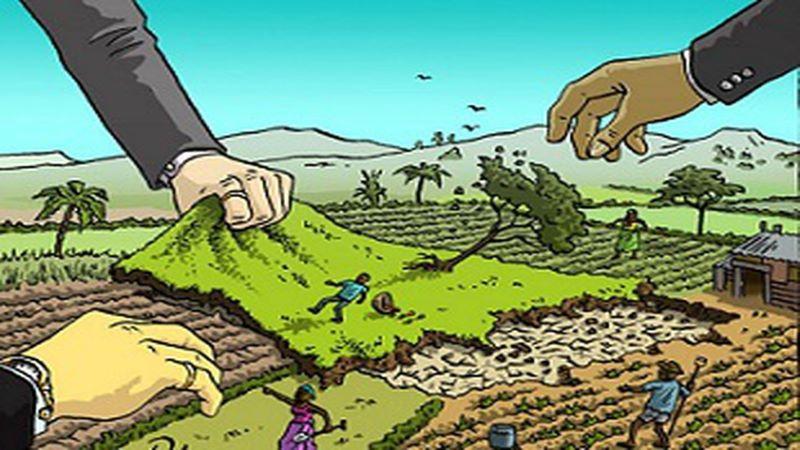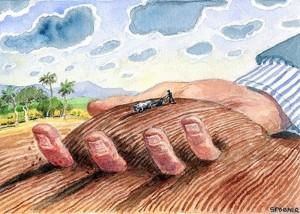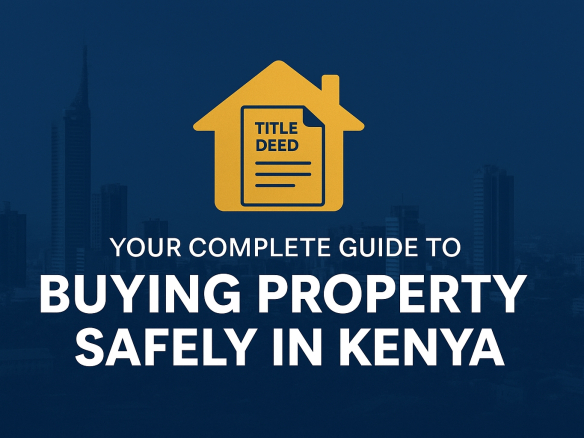Land Grabbing in Kenya: Causes, Methods, Real Cases, and How to Protect Yourself
Land is one of the most valuable assets in Kenya—not just in terms of money but also in terms of family heritage, community belonging, and future security. Unfortunately, this value has also made land one of the most contested resources in the country. Land grabbing in Kenya has persisted for decades, driven by fraudsters, corrupt networks, and sometimes even influential figures who exploit weak systems.
For ordinary Kenyans, land scams can mean the loss of life savings, family displacement, or years of court battles. For the government and investors, land grabbing delays development, drains resources, and erodes public trust in the real estate sector.
This comprehensive guide explores:
Why land grabbing is prevalent in Kenya
The common methods used by fraudsters
Real-life case studies that shocked the nation
The devastating impacts of land grabbing
Practical steps to protect yourself from scams
Whether you’re an individual buying a small plot, an investor, or simply curious about Kenya’s land sector, this guide gives you valuable insights and tools to stay safe.
Why Land Grabbing is Prevalent in Kenya
Kenya’s land challenges are rooted in a mix of history, corruption, demand, and weak systems. The following factors explain why land grabbing thrives:
High Demand for Land
Kenya’s rapid population growth, coupled with urban expansion and real estate booms, has created fierce competition for land. Prime land in Nairobi, Mombasa, Kisumu, and other fast-growing towns is extremely lucrative, attracting fraudsters.Weak Enforcement of Land Laws
Reforms like the Land Act 2012 and digitization via eCitizen have improved transparency, but enforcement remains weak. Disputes can take years or even decades in court, giving grabbers time to develop or resell contested land.Corruption in Land Offices
For decades, corruption at land registries has fueled scams. Fraudsters collude with insiders to create double titles, insert fake entries, or even issue unlawful allotments.Speculation Around Infrastructure Projects
Areas near planned highways, airports, or industrial parks become hotspots for fraudsters who illegally sell public land or road reserves at inflated prices.Historical Injustices
Colonial-era land policies and irregular allocations after independence left many disputes unresolved. Fraudsters exploit these grey areas to claim ownership of disputed parcels.Poor Public Awareness
Many Kenyans rush into buying land without conducting due diligence, engaging professionals, or even meeting the real owners. This makes them easy targets.
How Land Grabbing is Done in Kenya
Land fraud is not a simple act; it is a sophisticated, well-coordinated network that often involves multiple players. Here are the most common tactics:
Forgery of Documents – Fake title deeds, allotment letters, and IDs are created to deceive buyers.
Double Allocation of Land – Corrupt officers issue more than one title deed for the same parcel.
Impersonation – Criminals pose as genuine landowners, sometimes using fake relatives to add credibility.
Encroachment on Public Land – School grounds, road reserves, riparian areas, and forests are fenced off and sold.
Collusion with Insiders – Brokers, rogue lawyers, surveyors, and even land officials often aid fraudsters.
Bribery and Political Influence – Powerful grabbers use intimidation or political protection to legitimize illegal ownership.
Real-Life Case Studies of Land Grabbing in Kenya
To understand how serious and widespread land grabbing is, here are some real cases that shocked the country:
1. The Karen Land Scandal (2014)
In one of Kenya’s biggest land scandals, 134 acres of prime land in Karen, valued at KES 8 billion, was found to have multiple ownership claims. Several conflicting title deeds surfaced, allegedly issued with the help of corrupt officials. This case revealed how fraudulent records can create multiple “owners” for the same parcel of land.
2. Kyang’ombe Land Fraud (Embakasi, Nairobi)
Hundreds of residents in Kyang’ombe, near JKIA, were left homeless after it was revealed the land they bought was earmarked for airport expansion. Fraudsters, working with corrupt insiders, had sold them public land belonging to the Kenya Airports Authority (KAA). This highlighted how buyers can be duped into buying strategic public land, losing millions in the process.
3. Mau Forest Encroachment
The Mau Forest, Kenya’s largest water catchment area, has been repeatedly targeted by grabbers. Politically connected individuals irregularly acquired huge chunks, displacing communities and threatening the ecosystem. This case revealed that land grabbing doesn’t only affect private owners—it can devastate entire communities and the environment.
4. Grabbed Public Utility Land Across Counties
Reports by the National Land Commission (NLC) revealed that schools, hospitals, police stations, and even road reserves across counties have been fraudulently sold or allocated. For example, in some towns, hospitals discovered that their land had already been “sold” to private developers. These cases illustrate how land grabbing is a nationwide menace, not just confined to Nairobi.
How Land Grabbing Affects Kenyans/Investors
The impact of land grabbing goes beyond individual losses—it affects entire communities and the nation’s development:
Loss of Investments – Buyers lose life savings spent on fake or disputed land.
Development Delays – Infrastructure projects like roads, airports, and schools are stalled.
Social Conflicts – Families and communities engage in prolonged disputes.
Displacement – People are evicted from homes they’ve occupied for years.
Environmental Damage – Encroachment on forests, riparian zones, and wetlands harms ecosystems.
Reduced Investor Confidence – Foreign and local investors hesitate to engage in real estate due to fraud risks.
How to Protect Yourself from Land Grabbing and Scams
The good news is that buyers can take steps to protect themselves from falling victim. Here’s how:
1. Conduct a Land Search
Use eCitizen or visit the Ministry of Lands to confirm ownership, size, and encumbrances.
2. Engage Licensed Professionals
Always work with registered valuers, surveyors, and lawyers. They act as your safeguard.
3. Verify Ownership in Person
Meet the seller physically and verify their ID, KRA PIN, and signature against official documents.
4. Inspect the Land
Visit the site, confirm boundaries, and ensure there are no squatters or disputes.
5. Avoid Cash Transactions
Always pay through escrow accounts or bank transfers for accountability.
6. Check for Encumbrances
Ensure the land is not under a bank charge, caveat, or court dispute.
7. Confirm Survey Maps
Cross-check maps at the Survey of Kenya to confirm the land matches records.
8. Be Cautious with Cheap Deals
If the price looks too good to be true, it usually is.
9. Report Fraud Immediately
If you suspect fraud, report to the DCI, Ethics and Anti-Corruption Commission (EACC), or the National Land Commission (NLC).

Legal Frameworks and Policy Responses
In addressing the complexities surrounding land grabbing in Kenya, it is crucial to examine the existing legal frameworks and policy responses that have been implemented. The Constitution of Kenya (2010) lays a robust foundation by recognizing land as a critical resource for development, emphasizing community rights, and advocating for equitable access. However, the challenge remains in enforcement, where corruption, inadequate land registries, and lack of political will have hindered progress. Various laws, such as the Land Act (2012) and the National Land Policy, aim to facilitate fair land distribution, yet gaps still exist in their practical application. Key stakeholders, including governmental agencies, civil society, and affected communities, must advocate for the strengthening of these frameworks to bring about transformative change.
Policy responses have also been introduced to combat land grabbing, but their effectiveness is often undermined by systemic issues. Initiatives like the Community Land Act (2016) aim to empower communities by recognizing collective land ownership, which can serve as a bulwark against encroachment. Moreover, the government has launched programs aimed at enhancing transparency in land transactions and increasing public awareness on land rights. Stakeholder engagement through platforms such as community forums and workshops has become essential. Effective solutions should include:
- Enhancing Legal Literacy: Educating communities about their rights and legal protections can empower them to resist land grabbing.
- Promoting Community Ownership: Encouraging communal land registration to safeguard against illegal acquisition.
- Enforcement of Anti-Corruption Measures: Strengthening the integrity of land institutions to ensure accountability.
| Challenge | Proposed Solution |
|---|---|
| Weak Enforcement of Laws | Enhance capacity of land institutions |
| Corruption | Implement stronger anti-corruption strategies |
| Lack of Community Awareness | Conduct regular legal education workshops |
Conclusion
Land grabbing in Kenya is a serious threat to individuals, communities, and the nation at large. From the Karen scandal to Mau Forest encroachment, these cases prove that no land is safe from fraudsters. The mix of corruption, weak enforcement, and high demand continues to fuel the menace.
However, Kenyans can fight back. By conducting due diligence, engaging professionals, and avoiding shortcuts, buyers can protect themselves from devastating losses. More importantly, consistent public awareness, digitization of land records, and stronger enforcement are key to ending land grabbing once and for all.
Owning land in Kenya should be a source of pride and security—not anxiety. With vigilance and the right guidance, you can make safe investments and avoid falling into the traps of land grabbers.






Join The Discussion